Every parent’s deepest wish is the health and happiness of their child. In a world of changing viruses and new diseases, one of the greatest tools we have is simple, yet powerful: vaccination. When given on schedule, vaccines can build strong protection so your child can grow without fear of serious illness.
This guide will walk you through why vaccines matter, how they work, common concerns, and steps you can take to make smart and confident vaccination choices.
Why Vaccines Are Essential for Child Health
The Role of Vaccines in Preventing Illness
Vaccines act like a training session for the immune system. They introduce your child’s body to “safe versions” or parts of germs—such as proteins or inactivated molecules—so that the immune defense learns to fight real disease without causing the disease itself.
This way, when your child later encounters the real pathogen, his or her body responds quickly and strongly. Without vaccines, even minor infections could turn dangerous. Many illnesses disappeared or became very rare thanks to widespread immunization. When vaccine coverage drops, those diseases can return.
At Omega Pediatrics, preventive care—including vaccines—helps keep families out of hospitals and supports children in growing strong and healthy.
Community Immunity: Protecting Everyone
It’s not just your own child who benefits. When many children in a community are vaccinated, it becomes harder for a disease to spread. This is called herd immunity. It protects people who can’t get vaccinated—infants too young for shots, those with certain medical conditions, or immunocompromised individuals.
If vaccination rates fall, outbreaks become more likely. That’s why keeping up strong immunization is not just a personal choice—it’s a community responsibility.
The Most Important Childhood Vaccines You Should Know
Different vaccines protect against different diseases. Below is a helpful breakdown of key vaccines, what they prevent, and typical schedules. (Always follow your country’s official schedule or your pediatrician’s guidance.)
DTaP, Tdap, and Td
- DTaP protects against Diphtheria, Tetanus, and Pertussis (whooping cough).
- Tdap is a booster version for older children, teens, and adults.
- Td keeps protection against tetanus and diphtheria over time.
These vaccines prevent serious illnesses. For example, whooping cough can be deadly to infants, and tetanus (a wound-associated infection) is painful and dangerous. Omega Pediatrics has a detailed parents’ guide on DTaP, Tdap, and Td vaccines for deeper insights.
MMR (Measles, Mumps, Rubella)
The MMR vaccine protects against measles, mumps, and rubella. Two doses are usually given—first around 12–15 months, and again at 4–6 years. Each of these diseases can lead to severe complications:
- Measles can cause pneumonia, brain swelling, or death.
- Mumps may cause swelling in salivary glands, testicular swelling, or hearing loss.
- Rubella (especially dangerous during pregnancy) can cause birth defects.
Omega Pediatrics’ post The Importance of MMR Vaccine to Protect Your Child from 3 Illnesses provides more details about these benefits.
Polio (IPV / OPV)
Polio is a viral disease that can cause paralysis or even death. Vaccines for polio (either inactivated or oral forms) aim to prevent that drastic outcome. The doses are usually given at 2, 4, 6–18 months, and 4–6 years of age. Through vaccination, many countries have pushed polio toward elimination.
Hepatitis B
Hepatitis B is a liver infection that may become chronic and lead to severe liver damage or cancer later in life. That’s why infants often receive their first hepatitis B dose shortly after birth, followed by additional doses in the first year.
Rotavirus
Rotavirus causes severe diarrhea and vomiting in infants and young children. These symptoms can lead to dehydration, hospitalization, or worse. The rotavirus vaccine is administered orally in 2 or 3 doses during infancy (depending on brand).
Pneumococcal, Hib, and Other Vaccines
- Pneumococcal conjugate vaccine protects against Streptococcus pneumoniae, which can cause pneumonia, ear infections, meningitis, and bloodstream infections.
- Haemophilus influenzae type b (Hib) vaccine helps prevent meningitis and severe infections in young children.
- Human papillomavirus (HPV) vaccine is recommended in older children (often around age 9+) to reduce the risk of several cancers in adulthood.
- Influenza (flu) vaccine is often given annually, because flu viruses change each year.
How Vaccine Schedules Are Designed
Why do vaccines happen at specific ages? It’s not random. The schedule is based on careful research about when children are most vulnerable and when their immune systems are ready to respond well to each vaccine. For example:
- Babies are most at risk for certain infections in their first months.
- Some vaccines require multiple doses spaced out to build full immunity.
- Boosters maintain protection as immunity fades over time.
When schedules are updated, it is often because new evidence shows improved timing or better combinations—not because of safety concerns. If a child misses a dose, many immunization guidelines allow catch-up schedules so protection can resume without restarting.
Addressing Common Parent Concerns
It’s natural to have questions. Let’s talk through some of the most frequent worries with honesty, evidence, and respect.
Are vaccines safe?
Yes. Vaccines undergo vigorous testing in clinical trials and are monitored continuously after approval. The systems that track safety (such as adverse event reporting) make sure that new risks are detected and addressed.
Minor side effects—like soreness at the injection site, mild fever, or fussiness—are normal and expected. These are signs that the immune system is working. True serious reactions (like severe allergic response) are extremely rare. One myth is that giving many vaccines overwhelms a child’s immune system.
In truth, children’s immune systems face far more invaders in daily life than vaccines pose. Another myth is that “natural infection gives better immunity. While sometimes infection does confer strong immunity, the risks of complications, hospitalization, or worse are much higher than for vaccination.
It’s far safer to get immunity in a controlled way.
What if my child missed a shot or is behind schedule?
That can happen, especially in busy families or when there are disruptions (illness, moving, etc.). The good news: you usually don’t need to start over. Your pediatrician can create a catch-up schedule to get your child back on track.
Delaying or spacing out vaccines in ways that differ from the recommended schedule is often riskier. Alternative or delayed schedules haven’t been tested fully and can leave children vulnerable during critical windows.
Vaccines can cause autism or serious disease—is that true?
This is one of the most persistent fears among parents. However, extensive scientific research has found no credible, consistent evidence linking vaccines to autism. The apparent timing between early childhood vaccines and the age when autism is diagnosed is coincidental, not causal.
Doctors and scientists are always watching for safety signals. If any credible risk emerges, it would be investigated thoroughly.
Why vaccinate if some of these diseases are rare now?
Exactly because they are rare as a result of vaccination. Measles, polio, diphtheria, and many others are uncommon in many places—but that is thanks to high vaccine coverage. If we stop vaccinating, those diseases can—and often do—resurface.
Outbreaks in areas with low vaccine uptake offer a stark reminder: these infections never fully vanished—they were kept in check by immunization.
How You Can Be a Champion for Your Child’s Health
It’s one thing to understand vaccines, but another to act with confidence and support. Here are practical steps:
1. Plan and Track the Schedule
Use a vaccine schedule tracker (paper or digital). Mark upcoming doses and set reminders. Make sure you know what’s next, whether for infancy, tweens, or boosters later.
2. Ask Questions—Understand Each Vaccine
Don’t hesitate to talk with your pediatrician. Embracing informed consent builds trust and clarity. Ask:
- What disease does this vaccine prevent?
- What are the side effects?
- What is the benefit versus risk?
- Do we need a booster later?
3. Keep Records and Share Them
Always keep your child’s vaccine records. If you move, travel, or change doctors, share them. In many places, schools require proof of immunization for enrollment.
4. Stay Current with Updates
Researchers continually monitor diseases, immunity waning, and vaccine innovations. Sometimes, recommendations change. Stay connected with reliable sources—such as Omega Pediatrics’ blogs, national health departments, or WHO updates.
Omega Pediatrics frequently publishes guides and myth-busting posts about immunizations. Read: The Facts Behind Vaccine Safety: What Every Parent Should Know
5. Protect Others by Promoting Immunization
Encourage family members, caregivers, and friends to stay up to date. When more people in your community are immunized, everyone is safer—especially those who can’t receive vaccines themselves.
Special Considerations and Tips
Infants and Newborns
- Many guidelines call for a hepatitis B vaccine soon after birth.
- Combined vaccines (more than one protection in one shot) are common for infants to reduce the number of injections.
- Some vaccines are delayed until the baby is at least a few months old—because of how their immune system develops.
Adolescents and Teens
- The Tdap booster is often given between ages 11–12.
- The HPV vaccine (which helps prevent several cancers) is typically recommended around ages 9–12 or early teens.
- Some countries offer meningococcal vaccines to teens to reduce the risk of meningitis outbreaks.
Travel and Special Risks
If you plan to travel, check the required or recommended vaccines for the destination (yellow fever, typhoid, etc.). If your child has certain health conditions, allergies, or immune issues, your pediatrician may adjust timing or choice of vaccines.
Real Stories and Risks When Vaccines Are Skipped
To make it real: When communities skip vaccines, diseases come back. Measles outbreaks in areas with low vaccine coverage, cases of pertussis resurgence, or polio returning in regions where it was nearly eliminated—these are reminders that the fight is never done.
At Omega Pediatrics, we emphasize that not knowing enough about vaccines can put a child at risk. Misinformation spreads faster than facts, and when parents delay or refuse vaccines based on myths, they unintentionally increase danger.
These stories are not to scare but to remind that the protections vaccines give are real and powerful.
Summing Up and Taking Action
Vaccines are one of the safest, most effective ways to protect your child from serious illness. They don’t just help your child—they build a safer, healthier community. Here’s a checklist to empower you:
- Learn which vaccines your child needs and when.
- Keep a schedule and set reminders.
- Ask your pediatrician questions and stay informed.
- Hold onto vaccination records.
- Promote vaccination in your circle.
- Watch for updates or changes in recommendations.



